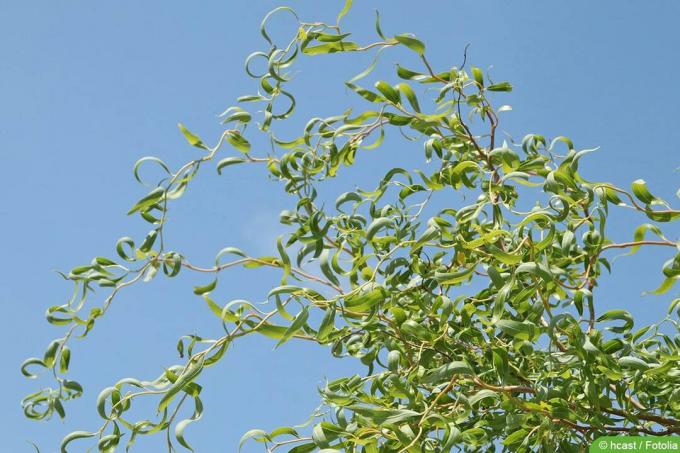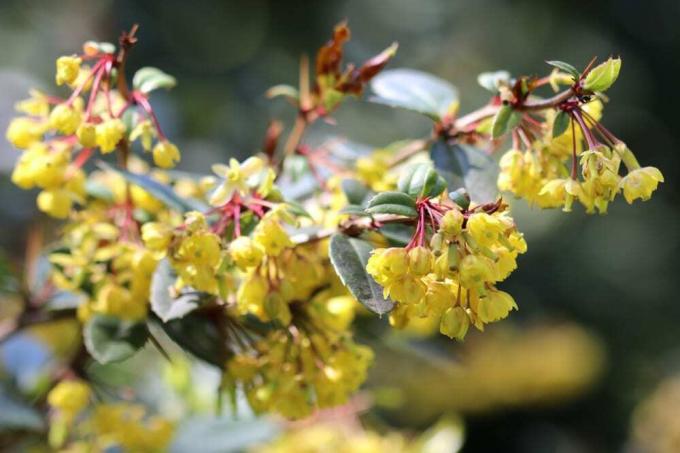

Table of contents
- How often does the pasture need to be cut?
- The best time for extensive cutting measures
- Consider the quality of the day
- Pruning tolerance of the corkscrew willow
- Cutting and quality of the tool
- Instructions for winter pruning
- Care after the "loss" of branches
- Raise young willow to a tree
- Properly trimming a potted specimen
- Pruning measures and root growth
The crown of the corkscrew willow should always shine in the best light. Because it is the sole reason why we bring this tree species into the garden. When nature throws them out of shape, the secateurs have to straighten them out in good time.
How often does the pasture need to be cut?
This cultivated willow species, with the scientific name Salix matsudana 'Tortuosa', grows very quickly. It can easily grow up to one meter per year. Some branches can develop differently than is conducive to the beautiful appearance of the crown. In addition, the tree can reach a maximum height of up to 10 m in the home garden. Only regular pruning can keep it small in a decorative way.
In order for both the height and the shape of the crown to almost always meet expectations, the Secateurs, sometimes also the saw, used from the first year and every year anew come. Of course, every cut is also a suitable means of maintaining and further promoting the health of the tree.
The best time for extensive cutting measures
The twisting branches of this willow grow numerous and quite close together. If they are also richly stocked with leaves during the warm time of the year, it will be difficult for even the most experienced cutter to get an overview of their arrangement. Therefore, the tree is ideally pruned in its leafless period.
- Period without leaves goes from about November to March
- act in late fall or early spring
- suitable days can also be found in between
Consider the quality of the day
The weather of the day is just as important for the success of the pruning measure as the time of year. The primary concern is the health of the tree. Moisture causes wounds to heal more slowly and promotes fungal diseases. Strong sunlight, on the other hand, can burn the fresh wounds. And by now every hobby gardener should have gotten the word that they don't cut on frosty days. In short, a good day is as follows:
- Frost free
- not too sunny
- overcast but not rainy
Pruning tolerance of the corkscrew willow
All beginners can confidently let go of the fear of wrong or too strong cuts, because this willow tolerates and forgives almost everything. As long as a sleeping eye remains on a branch, the tree will sprout again. Consequently, radical cuts may be made to keep the pasture small if necessary. Even if a few "due" knots were missed, or a few good knots accidentally removed, that will rapid growth in the warm part of the year, these flaws disappear under new growth, at least to the eye permit. The good pruning tolerance of the willow also makes it possible to remove or shorten annoying branches in summer if necessary.

Cutting and quality of the tool
All branches should be cut at an angle to allow moisture to drain better. Old branches may be cut back to a hand's breadth above the ground. If they are to sprout again, at least one eye must remain. Do not cut healthy branches so radically. On the one hand they are necessary for the crown build-up, on the other hand you avoid the formation of water shoots. The tool is chosen according to the strength of the branches.
- Cut thin branches with secateurs
- Saw off thick branches with a saw
- Cutting tool should be of good quality
- always clean and sharpened (otherwise shoots will be contaminated or damaged). squeezed)
Tip:
Also, remember to have a sturdy ladder ready so you can reach the higher branches without the risk of an accident.
Instructions for winter pruning
- First, get a full overview of the current structure of the crown. For this it is essential that you look at the tree from a reasonable distance and from all sides.
- Start with a thinning cut by first removing dead branches completely.
- Then take care of all the branches whose growth direction is disruptive. If necessary, step take a step back to get a better overall view.
- Remove 3-4 of the oldest branches to rejuvenate the willow
- If you want to keep the willow small, you can now shorten the remaining branches to the desired height.
- Finally, walk around the pasture again to examine the result of the cut and correct it if necessary. to touch up.
Tip:
If you have missed the pruning dates for a few years, you can breathe new life into the shrub with a radical rejuvenation pruning in spring.
Care after the "loss" of branches
After the cut, the time for new growth begins. You can support this by generously covering the root disc of the willow with a layer of mulch made of compost or horn shavings. Further care measures are not necessary. The pasture is only watered when it is very dry.
Raise young willow to a tree
Tree nurseries mostly offer corkscrew willows as shrubs. However, it is possible to raise them as a tree. This growth form is particularly suitable for willows that get a solitary position in the garden. You should lay the foundation in the first few years by pruning the Salix matsudana.

This happens as follows:
- Spread out over several years
- Cut off the bottom shoots on the main stem
- leave no stubs
- do not cut parallel, make the cut at a slight angle
- gradually remove further branches every year
- until the desired clearance height is reached
Properly trimming a potted specimen
Corkscrew willows can also be planted in large tubs. In order to keep them small, their owner must not miss the cut in any year. This is carried out in the same way as with a field specimen. The ideal period also remains unchanged from autumn to spring. However, it has proven to be more practical to reach for the pruning tool in the spring. In this way, the pruning measure can be combined with repotting.
Tip:
If you only change the substrate when repotting and keep the pot, it can make sense to cut back a root ball that has become too big.
Pruning measures and root growth
No matter how much you cut the Salix above the ground, root growth will continue unabated. However, since the root system of this willow strives so strongly to conquer surrounding areas, every willow owner should deal with this topic before planting. A root barrier or at least ample distance to neighboring properties and buildings is conceivable.
Tip:
If you want to reduce the root system afterwards, you have no other option than to expose and cut it.
 Home editorial office
Home editorial office
Learn more about trees & shrubs

Corkscrew willow, Salix matsudana: 13 tips for care
The corkscrew willow is a popular garden tree due to its decorative growth. Especially in winter, the species has a special character that is created by the twisted branches. The maintenance effort for the ornamental tree is limited.

Barberry - care, pruning & propagation
Barberries have been banned from domestic gardens for decades because they serve as a winter host for the black rust fungus. Today, the easy-care and undemanding shrubs can be found more often in the garden. However, planting can be subject to conditions imposed by the Plant Protection Office.

Corkscrew hazel (Corylus avellana): care from A to Z
The care of the corkscrew hazel is not particularly complex. Once the tree has found the perfect location, it can live up to 100 years and reach considerable growth heights. The undemanding species can easily be propagated or regenerated if necessary.

Cut faded flowers when lilacs: why and when?
Lilac is one of the undemanding flowering shrubs that require little care and grow almost anywhere without much intervention by the gardener. When the fragrant inflorescences of the lilac have faded, you should cut them out. Find out here what you should consider when cutting the flowers.

Bush tree care: planting, planting spacing and pruning
The bush tree is a limited-growing tree that is ideal for smaller gardens. These low to medium-growing fruit trees are available in many varieties. In view of the rather small growth habit, a rich harvest can still be expected.

Caring for the box tree properly - that's how it's done
For a magnificent growth, the boxwood makes some demands in terms of care. Whether watering, fertilizing, cutting or overwintering, with the right care, it will delight plant lovers for many years to come. The professional care instructions show how it works.



